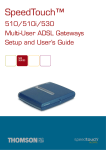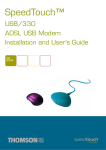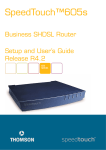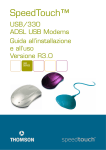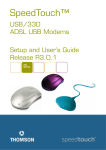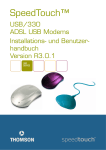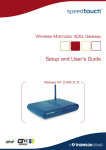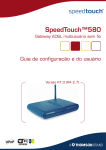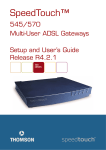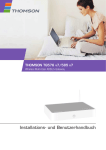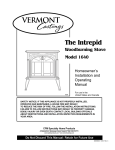Download Technicolor - Thomson 570i Network Router User Manual
Transcript
SpeedTouch™ 570/570i Wireless ADSL Routers Setup and User’s Guide 500 SERIES SpeedTouch™ 570 Setup and User’s Guide 3EC 17766 BAAA TCZZA Ed. 01 Status Change Note Short Title Copyright 3EC 17766 BAAA TCZZA Ed. 01 Released PeckelbeenS CD-UG ST570 R2.0 © 2002 THOMSON multimedia. All rights reserved. Passing on, and copying of this document, use and communication of its contents is not permitted without written authorization from THOMSON multimedia. The content of this document is furnished for informational use only, may be subject to change without notice, and should not be construed as a commitment by THOMSON multimedia. THOMSON multimedia assumes no responsibility or liability for any errors or inaccuracies that may appear in this document. Contents 3EC 17766 BAAA TCZZA Ed. 01 1 SpeedTouch™570 Installation ...................................... 7 1.1 Getting Acquainted with the SpeedTouch™570.............................................. 8 1.2 Preparing the SpeedTouch™570 ..................................................................... 10 1.3 Wireless Connectivity ....................................................................................... 13 1.3.1. First-time Wireless Client Connectivity ................................................................................... 15 1.3.2. Connecting other Wireless Clients ........................................................................................... 16 1.4 SpeedTouch™570 Configuration Setup .......................................................... 18 1.4.1. Configuration Setup for MS Windows OSs ............................................................................. 19 1.4.2. Configuration Setup for other OSs ............................................................................................ 24 1.5 SpeedTouch™570 Internet Connectivity........................................................ 26 2 SpeedTouch™570 Web Interface .............................. 29 2.1 System Tasks ...................................................................................................... 32 2.2 Other Places Tasks ............................................................................................ 36 3 Troubleshooting and Specifications ........................... 43 5 6 3EC 17766 BAAA TCZZA Ed. 01 1 SpeedTouch™570 Installation 1 SpeedTouch™570 Installation Introduction Thank you for purchasing the SpeedTouch™570 Wireless ADSL router! With the SpeedTouch™570 two cutting-edge technologies are combined: ADSL and the Wireless LAN (WLAN). With this answer to the increasing popularity of both technologies, users can connect to your (Wireless) network and surf the Internet at high speed without the need for any expensive wiring installation. In this Setup and User's Guide Terminology Quick installation and Safety instructions Documentation and software updates This Setup and User's Guide will assist you in getting acquainted with the SpeedTouch™570 and quickly connecting wired and wireless users to the Internet. For readability, both the SpeedTouch™570 and SpeedTouch™570i will be referred to as SpeedTouch™570 in this Setup and User's Guide. Prior to connecting the SpeedTouch™570 , read the SpeedTouch™ Quick Installation Guide and Safety instructions. Due to the continuous evolution of DSL technology, existing products are regularly upgraded. For more information on the newest technological breakthroughs, software upgrades and documents, please consult the SpeedTouch™ web sites at: • 3EC 17766 BAAA TCZZA Ed. 01 http://www.speedtouch.com 7 1 SpeedTouch™570 Installation 1.1 Getting Acquainted with the SpeedTouch™570 Introducing the SpeedTouch™ Prior to proceeding, please make sure to read first the SpeedTouch™ Quick Installation Guide . It provides important package content and safety information. Check whether all items are present in your package. In the event of damaged or missing items, please contact your local product dealer for more information. The SpeedTouch™570 SpeedTouch™ LEDs You SpeedTouch™ is presented in a slim line box: The SpeedTouch™570 is equipped with 5 LEDs on its front panel, indicating the state of the device during operation: Indicator Name Color State LAN Green Flashing Wireless LAN traffic activity Off No Wireless LAN activity Flashing Cell transmission on DSL line Off No transmission activity Flashing Cell reception from DSL line Off No reception activity Flashing Initialization of DSL line On DSL line synchronized Green On Power on, normal operation Amber Flashing WLAN client registration Line TX Line RX Line Sync PWR/Alarm 8 Description Green Green Green 3EC 17766 BAAA TCZZA Ed. 01 1 SpeedTouch™570 Installation SpeedTouch™570 back panel layout A Ethernet port LED functionality B C E F A Power button D Defaults button B Power inlet E 10/100Base-T Ethernet port C WLAN Registration button F DSL line port The Ethernet port on the rear panel has two LEDs: A B Indicator Description Name LED Status A Off 10Base-T Ethernet connection. Solid 100Base-T Ethernet connection. Off No connection on this port. Solid Ethernet link up. Flashing Data is flowing from/to this port. B 3EC 17766 BAAA TCZZA Ed. 01 D 10/100Base-T Integrity Activity 9 1 SpeedTouch™570 Installation 1.2 Preparing the SpeedTouch™570 Wall fixing assembly Part of the package is a wall mounting assembly which allows you to conveniently mount the SpeedTouch™570 on a wall. Before you start, check for the following items: • The wall fixing assembly • 2 screws and 2 wall plugs • 1 Velcro sticker. To prepare the wall fixing assembly and the SpeedTouch™570 , proceed as follows: Step 10 Action 1 Mark two hole horizontal positions, 134 mm (5.36 inches) apart: 2 Drill the marked holes with a 6mm (0.24 inches) diameter drill bit to a minimum depth of 35mm (1.38 inches). 3 Insert the wall plugs in the drilled holes, position the wall fixing assembly over the holes, insert the screws in the wall plugs and tighten them firmly: 4 Place the Velcro sticker on the wall fixing assembly in the marked area. 3EC 17766 BAAA TCZZA Ed. 01 1 SpeedTouch™570 Installation Step 5 Two variants Action Position the SpeedTouch™570 over the two hooks and slide the box down into place so that it is attached to the Velcro: Two ADSL variants of the SpeedTouch™570 Wireless ADSL Routers exist: • The SpeedTouch™570 : The ADSL/POTS variant connecting to an analog POTS(*) line • The SpeedTouch™570 i : The ADSL/ISDN variant connecting to a digital ISDN(**) line. You can identify your variant by checking the identification label located on the bottom of your SpeedTouch™570 . Use only the SpeedTouch™570 variant which is appropriate for the DSL service delivered to your premises. Check with your Service Provider to determine whether your SpeedTouch™570 is adapted to ADSL service requirements. (*) Plain Old Telephone Service (POTS) (**) Integrated Services Digital Network (ISDN) ADSL service The appropriate DSL service must be available your premises. • ADSL service must be enabled on your telephone line • As both telephone and ADSL service are simultaneously available from the same copper pair, you will need a central splitter or distributed filters for de coupling ADSL and telephone signals. Always contact your Service Provider when installing splitter/filters! Public telephone lines carry voltages that can cause electric shock. Only install splitter/ filters yourself if these are qualified for that purpose. Other splitter/filters may only be installed by qualified service personnel. Connect the ADSL line The DSL port on the SpeedTouch™570 is marked “Line”. Use the DSL cable provided to wire the SpeedTouch™570 DSL port to your telephone wall outlet. 3EC 17766 BAAA TCZZA Ed. 01 11 1 SpeedTouch™570 Installation Connect the power supply Always check first whether the power supply adapter provided is suitable for the local power specifications. Contact your Service Provider in case of any doubt. The power inlet on the SpeedTouch™570 is marked “DC”. Plug the adapter's coaxial jack into the SpeedTouch™570's power inlet. Turn on the SpeedTouch™570 Once all previous steps are completed, you can turn the SpeedTouch™570 on (I) with the power switch. The SpeedTouch™570 is ready for service as soon as the start-up procedures are completed, the Power On Self Test (POST) is passed and both Power/Alarm and Line Sync LEDs on the front panel are constantly lit green. For troubleshooting startup failures, see chapter “3 Troubleshooting and Specifications” on page 43. Local networking setup The SpeedTouch™570 offers two local networking solutions: • Wireless Ethernet The SpeedTouch™570 Wireless Ethernet allows multiple PCs to connect to your local network. To be able to connect the PCs, you must install a Wireless Ethernet client adapter (WLAN client) on each PC you want to connect via the Wireless Ethernet. For more information on how to proceed for associating and registering WLAN clients, see “1.3 Wireless Connectivity” on page 13. • Wired Ethernet The SpeedTouch™570's Ethernet port on the back panel allows you to connect the SpeedTouch™570 to an existing 10 or 100Base-T Ethernet network or a single computer with installed Ethernet card. • To connect the SpeedTouch™570 to a single computer, you can simply use the included straight-through Ethernet cable to connect both Ethernet ports. • For building a wired Ethernet network of multiple PCs, you must connect the SpeedTouch™570 to a hub or a switch. Note Internet connection setup 12 If a hub or switch is used for wired Ethernet networking, please follow the installation instructions supplied with the hub for connections and Ethernet cabling. To continue with preparing the SpeedTouch™570 for Internet connectivity, see “1.4 SpeedTouch™570 Configuration Setup” on page 18. 3EC 17766 BAAA TCZZA Ed. 01 1 SpeedTouch™570 Installation 1.3 Wireless Connectivity Introduction The SpeedTouch™570 features a Wireless LAN Access Point which behaves as a hub and allows wireless connectivity between several devices and the local (W)LAN and via the SpeedTouch™570 DSL router - to the public network, e.g. the Internet. WLAN technology enables these devices to communicate with each other in a locally mobile fashion, without the need for a wired environment. Wireless basics The WLAN's 'radio' link is a shared medium. As no physical connection exists between the SpeedTouch™570 and wireless clients, a name must be given to allow unique identification of your WLAN radio link. This is done by the Service Set ID (SSID). Wireless clients must be part of this SSID environment in order to be able to communicate with other clients on the (W)LAN - including the SpeedTouch™570 . The IEEE802.11b standard for WLANs allows several WLAN networks using different radio channels to be co-located. Several channels are available for use which are associated to a slightly different frequency in the allowed range. The SpeedTouch™570 supports operation on all allowed channels and is able to select the best radio channel at each start-up. Wireless security Since the SpeedTouch™570 (W)LAN environment is a radio environment, precautions must be taken to ensure that your wireless network is safe from malicious intruders. In addition to providing the possibility of giving a personalized SSID name to the wireless network, the SpeedTouch™570 features a physical registration mechanism, an Access Control List (ACL) and enhanced Wired Equivalent Privacy (WEP) 64- or 128-bits encryption to secure your network and to control wireless client access. Wireless client requirements Only WLAN client adapters compliant to IEEE802.11b DSSS, will be able to communicate with the SpeedTouch™570 , and with the other members of the SpeedTouch™570 (W)LAN environment. It is advisable that the WLAN client adapter is Wireless Ethernet Compatibility Alliance (WECA) Wi-Fi™ (*) certified to ensure smooth interoperability. To use SpeedTouch™570 's encryption security features, the WLAN client adapters should at least support 64-bit WEP encryption. (*) Wireless-Fidelity (Wi-Fi) Recommended Wireless client adapters Only WLAN client adapters compliant to IEEE802.11b DSSS, will be able to communicate with the SpeedTouch™570, hence with other members of the SpeedTouch™570 Wireless LAN environment. It is advisable that the WLAN client adapter is Wireless Ethernet Compatibility Alliance (WECA) Wi-Fi certified to ensure smooth interoperability. 3EC 17766 BAAA TCZZA Ed. 01 13 1 SpeedTouch™570 Installation Default configuration When the SpeedTouch™570 leaves the factory and after every Push-to-Defaults, the SpeedTouch™570 wireless configuration returns to its initial default settings. These settings are as follows: 14 • The default SSID is printed on the identification label located on the bottom of your SpeedTouch™570: This unique SSID consists of the word “SpeedTouch” followed by the 6 last characters of the SpeedTouch™570 WLAN access point MAC address, without any spaces. • By default SpeedTouch™570 automatically selects the best DSSS radio channel number at each start-up. • The 'Registration' button is activated by default. • Access Control List is empty and locked by default. • WEP encryption is disabled by default. 3EC 17766 BAAA TCZZA Ed. 01 1 SpeedTouch™570 Installation 1.3.1. First-time Wireless Client Connectivity Initial SpeedTouch™570 wireless configuration When the SpeedTouch™570 leaves the factory and after every Push-to-Defaults, the SpeedTouch™570 wireless configuration returns to its initial default settings. These settings are as follows: Preconditions for a successful first-time WLAN client registration • The SSID is as printed on the identification label located on the bottom of your SpeedTouch™570 . • The DSSS radio channel number is set to “automatic”. • The 'Registration' button is activated. • The Access Control List is empty and locked. • WEP encryption is disabled. Make sure that: • The SpeedTouch™570 is powered on and ready for service. • The SpeedTouch™570 is in its default configuration. If needed, perform a push-to-defaults via its default button. • The WLAN client adapter is installed on your computer. By default the WLAN client adapter’s IP configuration is set to dynamically obtain its IP configuration (DHCP). • The WLAN client is correctly configured for the default SpeedTouch™570 SSID, hence associated to the SpeedTouch™570 WLAN. Depending on your WLAN client a wireless icon may become green or a message similar to the following may pop up: “Successfully joined Wireless network SpeedTouch012345". Note Registering the first WLAN client Some WLAN clients do not automatically join a WLAN. If so, follow the instructions for the WLAN client software to initiate the association. Proceed as follows: Step Action 1 Make sure that all preconditions mentioned above are met. 2 Push the red Registration button on the SpeedTouch™570 back panel. 3 Make sure the WLAN client is correctly associated again to the SpeedTouch™570 WLAN. Depending on your WLAN client adapter a wireless icon may become green or a message similar to the following may pop up: “Successfully joined Wireless network SpeedTouch012345". Note 4 3EC 17766 BAAA TCZZA Ed. 01 Some WLAN clients do not automatically join a WLAN. If so, follow the instructions for the WLAN client software to initiate the association. As a result the WLAN client is associated to the default SpeedTouch™570 Wireless environment and registered to the Access Control List. 15 1 SpeedTouch™570 Installation 1.3.2. Connecting other Wireless Clients Before you connect other WLAN clients Before associating and registering further WLAN clients, it is recommended that you first proceed with the configuration setup procedures as described in section “1.4 SpeedTouch™570 Configuration Setup” on page 18. For enhanced security, after going through the SpeedTouch™570 configuration setup procedures, you are able to “personalize” the SpeedTouch™570 Wireless configuration by configuring another SSID, and optionally enabling WEP encryption. After re-associating the first WLAN client adapter with the “personalized” Wireless configuration, you can register the remaining WLAN clients allowed to join your WLAN. For more information on the configuration of the SpeedTouch™570 Wireless configuration, see chapter “2 SpeedTouch™570 Web Interface” on page 29. Preconditions Make sure that: • The SpeedTouch™570 is powered on and ready for service. • The SpeedTouch™570 has been configured by the SpeedTouch™ Setup wizard or via uploading the appropriate configuration profile file. • Optionally, the SpeedTouch™570 WLAN settings have been personalized. Further make sure that: • The WLAN client adapter is installed on your computer. Depending on the personalized WLAN configuration: 16 • In case WEP encryption is enabled on the SpeedTouch™570 , you must configure the WLAN client for using the same WEP key. • Configure the WLAN client for the SpeedTouch™570 SSID, hence associated to the SpeedTouch™570 WLAN. • Depending on the registration button and Access Control List configuration: • In case the registration button is disabled and the Access Control List unlocked, no further actions are needed for the WLAN client to access the SpeedTouch™570 WLAN network. • In case the registration button is disabled and the Access Control List locked, you must manually add the WLAN client to the Access Control List as described in “ Wireless” on page 40. • In case the registration button is enabled and the Access Control List locked, you must follow the procedure below to register the WLAN client to the SpeedTouch™570 Access Control List. 3EC 17766 BAAA TCZZA Ed. 01 1 SpeedTouch™570 Installation Registering Wireless clients In case the registration button is enabled, you must register pending WLAN clients as follows: Step Action 1 Make sure that all preconditions mentioned above are met. 2 Push the red Registration button on the SpeedTouch™570 back panel or click the 'Registration' button on the SpeedTouch™570 Wireless web page via an already registered and connected computer. 3 Make sure the WLAN client is correctly associated again to the SpeedTouch™570 WLAN. Depending on your WLAN client adapter a wireless icon may become green or a message similar to the following may pop up: “Successfully joined Wireless network SpeedTouch012345". Note 4 3EC 17766 BAAA TCZZA Ed. 01 Some WLAN clients do not automatically join a WLAN. If so, follow the instructions for the WLAN client software to initiate the association. Browse to the SpeedTouch™570 Wireless web page to see that the MAC address of your WLAN client is added to the ACL table. Note: If a system password secures the SpeedTouch™570 from unauthorized access, you'll need to authenticate first before you can actually browse its web pages. 17 1 SpeedTouch™570 Installation 1.4 SpeedTouch™570 Configuration Setup Internet connectivity As soon as the SpeedTouch™570 is prepared as described in section “1.2 Preparing the SpeedTouch™570” on page 10 and the first-time WLAN client is registered to the SpeedTouch™570 WLAN according to subsection “1.3.1. First-time Wireless Client Connectivity” on page 15, the SpeedTouch™570 can be prepared for Internet connectivity. What you need from your ISP You must have a user account with an Internet Service Provider (ISP) for Internet access: For this user account, it will provide you with: • A user name (logon ID) • A password. Other information might be required depending on the provided CD-rom and/or specific requirements of the ISP. Configuration of the SpeedTouch™570 Depending on your computer's Operating System (OS) the configuration of your Internet connectivity can be done automatically or manually. In case your computer runs: • A Microsoft Windows OS From the included SpeedTouch™ Setup CD-rom a wizard will automatically guide you through the configuration of both the SpeedTouch™570 and your PC for setting up the appropriate configuration. See subsection “1.4.1. Configuration Setup for MS Windows OSs” on page 19. • Another OS, e.g. Mac OS, Unix, Linux, etc. The configuration of the SpeedTouch™570 is semi-automatically done by uploading the appropriate configuration file to your SpeedTouch™570 . If needed, additional configuration of your computer must be done manually. See subsection “1.4.2. Configuration Setup for other OSs” on page 24. 18 3EC 17766 BAAA TCZZA Ed. 01 1 SpeedTouch™570 Installation 1.4.1. Configuration Setup for MS Windows OSs Microsoft Windows One of the following OSs must be installed on your PC(s): • Microsoft Windows 95 • Microsoft Windows 98 or 98SE • Microsoft Windows ME • Microsoft Windows NT4.0 • Microsoft Windows 2000 • Microsoft Windows XP. You may need the Windows installation CD-rom during installation. TCP/IP Make sure that TCP/IP (*) is installed on your PC(s). (*) Transmission Control Protocol (TCP) / Internet Protocol (IP) The SpeedTouch™ Setup Wizard The SpeedTouch™ Setup wizard can be divided in into two parts: • The detection procedure • The configuration procedure. The detection procedure Step 1 Action Insert the SpeedTouch™ Setup CD-rom in your PC's CD-rom drive. The wizard will start automatically. Note 2 If the wizard does not start automatically, open a 'Run' window via Start > Run from the Start menu and enter the following path: D:\Setup.exe, where D is the drive letter of your CD-rom drive. The SpeedTouch™ Welcome window pops up: To start the SpeedTouch™ Setup wizard, click SpeedTouch™ Setup. 3EC 17766 BAAA TCZZA Ed. 01 19 1 SpeedTouch™570 Installation Step 3 Action The Welcome to the SpeedTouch™ Setup Wizard window pops up: Click Next to proceed. 4 The Software License Agreement for SpeedTouch™ window pops up: Click Yes to accept the terms of the agreement and to continue with the Setup wizard. 5 20 The Setup wizard will continue by searching for SpeedTouch™ devices on the network. The following window shows the detection progress: 3EC 17766 BAAA TCZZA Ed. 01 1 SpeedTouch™570 Installation Step 6 Action The setup wizard should find your SpeedTouch™570 device on the local network. This is indicated by following window: If the Setup wizard does not find an SpeedTouch™570 on the network an error window pops up. In this case check: • Whether your PC is correctly wired to the SpeedTouch™570 or the WLAN client is correctly registered to the SpeedTouch™570 WLAN as described in “1.3.1. First-time Wireless Client Connectivity” on page 15. • That no dedicated firewall device or router is placed between your PC and the SpeedTouch™570 and that no personal firewall software is running on your PC • Whether the SpeedTouch™570 is powered on and fully initialized. Note In case of MS Windows 95 or Windows NT4.0 it is advised to configure the PC with a static IP address, e.g. 10.0.0.1. Make sure however not to use the IP address 10.0.0.138 as it is the SpeedTouch™570 's default IP address. To repeat the search for the SpeedTouch™570, click Back and proceed with step 5 of this procedure. 7 3EC 17766 BAAA TCZZA Ed. 01 To continue with the configuration of the SpeedTouch™570 and your PC, proceed with the configuration procedure described below 21 1 SpeedTouch™570 Installation The configuration procedure Step 1 Action Once the the SpeedTouch™ Setup wizard has detected the SpeedTouch™570 device you can proceed with the configuration procedure. If more than one SpeedTouch™ device is listed, select the appropriate one. Then, click Next to proceed. Note 2 If the SpeedTouch™570 has been configured before, it may be protected by a system password. You must provide this password before you can view the device details or continue with the configuration. The following window invites you to select the appropriate connection profile for your Internet connectivity: Select the connection profile and click Next to continue. Note 22 If the Service Provider included a separate disk with a dedicated connection profile, click Have disk to navigate to the location of the appropriate connection profile file. 3 Subsequent screens will guide you through the configuration setup of both your SpeedTouch™570 and/or your PC. Follow the instructions and enter the required information where needed. This information should be provided by your Service Provider. 4 In final step all configurations will be applied to the SpeedTouch™570 and your PC. You can follow the configuration progress in following window: 3EC 17766 BAAA TCZZA Ed. 01 1 SpeedTouch™570 Installation Step 5 Action The SpeedTouch™ Setup wizard will appear again to announce that the configuration has been successful: Click finish to close the wizard. 6 For enhanced security, after going through the SpeedTouch™570 configuration setup procedures, you are able to “personalize” the SpeedTouch™570 Wireless configuration. See “1.3 Wireless Connectivity” on page 13 for more information. In case you want to enable multiple PCs on your local network for accessing the SpeedTouch™570 and the Internet, no additional configuration of your PCs must be done in most cases, except the WLAN client configuration. This because most configuration profile will enable the SpeedTouch™570 DHCP server - and a PC’s Ethernet interface is configured as DHCP client by default. To make sure that all PCs are configured as expected (DHCP or fixed IP addresses) you can re-run the SpeedTouch™ Setup wizard on every PC. For fixed IP configurations, or other advanced settings, please follow the instructions provided by your ISP or network administrator. 3EC 17766 BAAA TCZZA Ed. 01 23 1 SpeedTouch™570 Installation 1.4.2. Configuration Setup for other OSs Supported OSs As the SpeedTouch™570 is OS-independent, this configuration setup can be used by any computer system Note TCP/IP The following procedure may equally be used on MS Windows OSs. Make sure that your Operating System has a valid TCP/IP configuration. Configure the wireless computer for the correct default WLAN settings (See “1.3 Wireless Connectivity” on page 13) and with a static “Net10” private IP address, e.g. 10.0.0.1. Ensure, however, that you do NOT use the 10.0.0.138 IP address as this is the default IP address of the SpeedTouch™570. To ensure that IP connectivity exists, you can ping the SpeedTouch™570. Procedure Step Action 1 To make sure that the SpeedTouch™570 is in its factory default state, perform a reset to defaults. 2 Register the first-time WLAN client according to subsection “1.3.1. First-time Wireless Client Connectivity” on page 15. 3 Open a web browser and browse to the SpeedTouch™570 's default IP address 10.0.0.138. See chapter “2 SpeedTouch™570 Web Interface” on page 29 for more information. 4 As a result the SpeedTouch™570 System info page appears. Expand the Advanced Topics and click Upgrade to open the Upgrade page. 5 In the Configuration table you can overview the current (default) configuration settings active on the SpeedTouch™570. Click Browse to locate the configuration file on the CD-rom provided or disk. Note 24 If the path is known you can immediately enter it in the location input field. 6 Once the location to the appropriate configuration profile is selected, click Upload. 7 The file will be uploaded to the SpeedTouch™570. Once uploaded, click Restart to restart the SpeedTouch™570 and activate the uploaded configuration. 8 After restarting the SpeedTouch™570 some additional configuration of your computer system might be needed. Note: The required settings for your computer should be provided by your Service Provider, if applicable. 3EC 17766 BAAA TCZZA Ed. 01 1 SpeedTouch™570 Installation Step 3EC 17766 BAAA TCZZA Ed. 01 Action 9 To check whether the activation of the uploaded configuration was successful, you can browse to the SpeedTouch™570 and overview the current configuration. 10 It is advised to “personalize” the SpeedTouch™570 WLAN configuration. See chapter “2 SpeedTouch™570 Web Interface” on page 29 for more information. 11 If applicable, register the remaining WLAN clients. See subsection “1.3.2. Connecting other Wireless Clients” on page 16 for more information 25 1 SpeedTouch™570 Installation 1.5 SpeedTouch™570 Internet Connectivity Surfing the Internet Access methods Once the SpeedTouch™570 and the PC(s) are configured as outlined in section “1.4 SpeedTouch™570 Configuration Setup” on page 18, you can connect to the Internet. The SpeedTouch™570 supports two access methods: • Direct access Once initial configuration is done, continuous and immediate access is available via the DSL line. • Dial-in access Access must be explicitly established, e.g. by “dialing” into a Remote Access Server (RAS), e.g. via the SpeedTouch™570 embedded PPP dial-in connections page. Note The dial-in access service may require a third party dial-in application. In this case the appropriate software has to be supplied by your Service Provider. The method used depends on the configuration profile/file you used to configure the SpeedTouch™570 and the Service Provider's requirements. Your Internet connection Regardless of whether the direct access or a dial-in access method is used to make your connection, once the connection is established, opening your web browser is enough to access the World Wide Web (WWW) or Internet. Note In some cases, e.g. in case of Bridged Ethernet, the remote organization might ask for a user name and password on an Internet welcome page. An example of how to establish a PPP dial-in connection via the SpeedTouch™570 embedded dial-in client is provided on the next page. The SpeedTouch™570 web pages Your SpeedTouch™570 offers a user-friendly web interface. Via the web pages you are able to establish dial-in connections, configure some advanced settings, e.g. the SpeedTouch™570 DNS server or NAPT server or overview the WLAN configuration and settings, some statistics of your SpeedTouch™570 itself and its ADSL connectivity, etc. See chapter “2 SpeedTouch™570 Web Interface” on page 29 for more information 26 3EC 17766 BAAA TCZZA Ed. 01 1 SpeedTouch™570 Installation Embedded SpeedTouch™ Dial-in application You can establish dial-in connections, pre-configured by the SpeedTouch™ Setup wizard or by uploading the appropriate configuration file. The SpeedTouch™570 supports both two most popular connection methods: Routed PPP over ATM (PPPoA) and PPP over Ethernet (PPPoE). The connection method to use depends on the preferences of your ISP, hence the configuration profile you must apply to the SpeedTouch™ Note Starting a PPP session The following description provides only an example of how you can establish Internet connectivity by starting Routed PPP connections. The SpeedTouch™570 supports various other methods for Internet access. The actual implementation depends on the preferences of your Service Provider. To open a Routed PPP connection to the Internet: Step Action 1 Open a web browser on your PC/computer and browse to the SpeedTouch™570 web page: 2 If needed, expand the System tasks, and click Dial-in to open the Connections page. 3 In the Dial-in Connections table all configured Routed PPP entries are shown. In the Interface column select the entry you want to start a session with. As a result the entry will be highlighted. 4 If not provided yet, enter your user name and password in the appropriate fields. If you want the SpeedTouch™ to remember your credentials, select 'Save this password'. Note 5 3EC 17766 BAAA TCZZA Ed. 01 If applicable, enter the appropriate Service name. This name should be provided by your ISP, if required. Click Connect. While the SpeedTouch™ tries to start the session 'trying' appears in the State column of the entry. Once the session is started successfully the field displays 'up'. From then on you are online and you can start your application or browse the Internet. 27 1 SpeedTouch™570 Installation Terminating an opened PPP session To close an active Routed PPP connection: Step 28 Action 1 Ensure that you have access to the SpeedTouch™ web pages. 2 Browse to the SpeedTouch™ Connections page. 3 Select the connection entry you want to terminate the session for. 4 Click Disconnect. The entry's session state will change to 'Down', i.e. it becomes idle. 3EC 17766 BAAA TCZZA Ed. 01 2 SpeedTouch™570 Web Interface 2 SpeedTouch™570 Web Interface Introduction The SpeedTouch™570 comes with integrated local configuration capabilities. The local configuration, via the SpeedTouch™570 web interface, is based on the HTTP server/web browser concept. It allows you to configure your SpeedTouch™570 via a web browser using HTML pages from any local computer attached to the SpeedTouch™570 (Wireless) LAN. Requirements Before you access the SpeedTouch™570 pages, make sure that your browser is configured to directly connect to the SpeedTouch™570, I.e. that it is not using a Proxy server. If required, you can disable the proxy server for the time you want to access the SpeedTouch™570 web pages. For more information on how to disable your web browser's proxying, please consult the web browser's help pages. Use of the SpeedTouch™570 web interface In most cases, the SpeedTouch™570 is correctly configured for your Internet connectivity via the appropriate configuration profile/file and no further configuration on the web interface is needed. Access to the web pages is only required for some advanced configurations and upgrading/updating or backing up the SpeedTouch™570 configuration. Access to the SpeedTouch™570 web interface 3EC 17766 BAAA TCZZA Ed. 01 To access the SpeedTouch™570 web pages: Step Action 1 Start the web browser on your PC or computer. 2 Browse to the SpeedTouch™570 at the SpeedTouch™'s IP address (in most cases 10.0.0.138). 3 If a system password has been set, an authentication window will be displayed. Enter user name and system password in the appropriate fields. 29 2 SpeedTouch™570 Web Interface Result As a result the System Info page appears: From now on, the SpeedTouch™570 acts as a web server, sending HTML pages/forms at your request. You can fill out these pages/forms and submit them to the SpeedTouch™570. The latter scans the pages and performs the appropriate configurations. Topic menu and links On the left of each of the SpeedTouch™570 web pages a topics menu is provided. This menu navigates you via links through all configurational aspects of the SpeedTouch™570. For your convenience the links are sorted in two expandable topics menus: System Tasks and Other Places. The links in the System tasks menu lead you to pages for basic SpeedTouch™570 configuration and maintenance, i.e. the pages for every-day use. The Other Places menu, contains the links which allow advanced configuration of the SpeedTouch™570. These pages need only to be accessed for some specific operations, e.,g. re-configuring the Wireless settings. The following table lists all System menu links: SYSTEM menu 30 Click ... To ... “ Dial-in” Establish dial-in connections. View the SpeedTouch™ connection information. “ Status” View the current configuration profile. View the current ADSL line status. “ System Setup” Set a system password. View the SpeedTouch™ system information. “ Upgrade” Backup and/or upload configuration profiles/files. Restore the SpeedTouch™ default settings. 3EC 17766 BAAA TCZZA Ed. 01 2 SpeedTouch™570 Web Interface The following table lists all Other Places topic links: OTHER PLACES menu Help Click ... To ... “ Routing” View/configure the SpeedTouch™ IP interfaces and IP router. “ DNS” View/configure the SpeedTouch™ DNS server/client. “ DHCP” View/configure the SpeedTouch™ DHCP server/client. “ NAT” View/configure static NAPT entries. Define a default local server for inbound connectivity. “ Wireless” View/configure SpeedTouch™570 Wireless LAN settings. The Help link in the topics menu header allows you to browse the SpeedTouch™570 online Help. For more information on a specific topic you can click the context-related Help links located at the Topic's web pages. Save all It is advised to save the SpeedTouch™570 configuration and to back it up whenever you made changes to its settings. To save the configuration click the Save All link in the topics menu header. For backing up the SpeedTouch™ configuration, see “ Upgrade” on page 34. 3EC 17766 BAAA TCZZA Ed. 01 31 2 SpeedTouch™570 Web Interface 2.1 System Tasks Dial-in Click this button to display the Connections page. This page allows you to: • Establish dial-in connections, if applicable: See section “1.5 SpeedTouch™570 Internet Connectivity” on page 26 for more information on how to use the Dial-in Connections table. • Status View detailed connection information by clicking the here link. Click this button to display the Configuration & Line Status page. This page is also the SpeedTouch™570 “home”page. It allows you to: 32 • View which configuration profile/file is currently loaded, including information on which Region and ISP this configuration applies to: • View the current physical status of the ADSL line: 3EC 17766 BAAA TCZZA Ed. 01 2 SpeedTouch™570 Web Interface System Setup Click this button to display the System Setup page. This page allows you to: • Configure a System password to restrict access to the SpeedTouch™570 : It is highly recommended that you configure a System password. To protect the SpeedTouch™570 you should change the System password on a regular basis. However, never use an obvious password such as your name, date of birth, etc. Enter the System password of your choice and re-enter it in the appropriate fields. Click Apply to apply the System password and Save All to save your changes to persistent memory. Note • 3EC 17766 BAAA TCZZA Ed. 01 As long as no System password is supplied, a warning is displayed on the SpeedTouch™570 web pages. View SpeedTouch™570 device related system information: 33 2 SpeedTouch™570 Web Interface Upgrade Click this button to display the Software- and Configuration Upgrade page. This page allows you to: • Upgrade the SpeedTouch™570 system software: Therefor: Step 1 Action Before you start upgrading the SpeedTouch™570 software, you must have an upgrade software package available on a CD-rom provided or local disk. Note Upgrade software may be made available from your Service Provider. Contact your Service Provider for more information. 2 Make sure no passive software is stored on the SpeedTouch™570. If needed click Remove passive to remove a passive software version. 3 Click Browse to locate the SpeedTouch™570 upgrade software on your disk or CD-rom provided. Note 4 If the path is known you can immediately enter it in the location input field. Click Upload. As a result the SpeedTouch™570 upgrade system software name will appear in the 'Passive software version' field. Note 5 Uploading software may take up to four minutes to complete. Click Switch over. As a result the SpeedTouch™570 will switch the two system software versions, will reboot and come online with the upgrade system software. Saved configurations remain unchanged. 34 3EC 17766 BAAA TCZZA Ed. 01 2 SpeedTouch™570 Web Interface • Back up the current SpeedTouch™570 configuration, restore the SpeedTouch™570 default configuration, or upload a new configuration file: To back up the current configuration, click Backup and follow the instructions. To restore the SpeedTouch™570 defaults, click Restore Defaults to load the default configuration. Click restart to reboot the SpeedTouch™570 and allow the changes to take effect. To upload a new configuration and apply a new or backup SpeedTouch™570 configuration file, click Browse to go to the location where the SpeedTouch™570 upgrade configuration file resides. Select it and click Upload to upload the file. Click restart to reboot the SpeedTouch™570 and allow the changes to take effect 3EC 17766 BAAA TCZZA Ed. 01 35 2 SpeedTouch™570 Web Interface 2.2 Other Places Tasks Routing Click this button to display the IP Address- and Routing Tables page. This page allows you to: • View or add/delete specific IP address entries for the SpeedTouch™570’s interfaces: You can add a static IP address for one of the SpeedTouch™570 's interfaces by clicking New. Specify the IP address, (sub)netmask, whether NAPT should be applied to this address, and select the interface for which the IP address applies (use eth0 for the Ethernet interface). Click Apply to add the entry to the table. All essential IP routes associated with this IP address will be automatically added to the SpeedTouch™570 IP routing table. • View or add/delete static IP routes for the SpeedTouch™570’s IP router: Routing can be useful when subnetting your local network. You can add a static IP route by clicking New. Specify the destination IP address (use the prefix notation to apply a subnetmask), source IP address (use the prefix notation to apply a subnetmask), and specify the gateway IP address or select the interface for this route. Click Apply to add the entry to the table. 36 3EC 17766 BAAA TCZZA Ed. 01 2 SpeedTouch™570 Web Interface DNS Click this button to display the Dynamic Name System (DNS) page. This page allows you to: • View and/or supply the SpeedTouch™570 DNS domain name and to enable/ disable the SpeedTouch™570 DNS server: Note • The use of DNS subdomains is supported, e.g. dsl.office.lan. Overview the current SpeedTouch™570 DNS server hostname leases: Via this table you can also add static DNS hostname entries. This may be useful for devices which do not support DNS, e.g. a printer. By adding a name for your network printer, identified by its IP address, you will be able to contact this printer by name rather than by IP address. DHCP Click this button to display the Dynamic Host Configuration Protocol (DHCP) page. This page allows you to: • Enable/disable the SpeedTouch™570 (Auto)DHCP server: The SpeedTouch™570 features a DHCP server which allows the PCs/computers on your local network to automatically obtain an IP address (select DHCP Server). If DHCP is not used on your local network, the SpeedTouch™570 DHCP server can be disabled (select No DHCP). The SpeedTouch™570 can also search for another DHCP server (select AutoDHCP) . If so, it slips into DHCP client mode, if not the SpeedTouch™570 becomes DHCP server. Click Apply to apply your selection. 3EC 17766 BAAA TCZZA Ed. 01 37 2 SpeedTouch™570 Web Interface • Configure the SpeedTouch™570 DHCP server lease pool properties: The SpeedTouch™570 DHCP server (if enabled) will use the address pools listed in this table to provide IP addresses to requesting DHCP clients. To configure a user-defined IP address pool (appropriate to your local network conditions) click New and provide the required information. Click Apply to add your entry to the table. • View the current leases provided by the SpeedTouch™570 DHCP server: Using this table you can also manually add static DHCP leases for specific hosts, if applicable. • View the current SpeedTouch™570 DHCP client status: Via this table you can also manually add static SpeedTouch™570 DHCP client entries for specific interfaces, if applicable. 38 3EC 17766 BAAA TCZZA Ed. 01 2 SpeedTouch™570 Web Interface NAT Click this button to display the Network Address and Port Translation (NAPT) page. This page allows you to: • Overview or add/delete specific static NAPT entries: You can add static NAPT entries by clicking New. Specify the outside address and inside address for the entry as well as the protocol and port to which the entry applies. If the NAPT entry is applied to a connection’s dynamically assigned local peer IP address, you should specify 0.0.0.0 as the outside address. Click Apply to add the entry to the table. • Define a default server: By specifying a default server IP address all incoming connections will be forwarded to the device with this IP address. In most cases this setting should be adequate for most server applications and will make the need for specific static NAPT entries redundant. 3EC 17766 BAAA TCZZA Ed. 01 39 2 SpeedTouch™570 Web Interface Wireless Click this button to display the SpeedTouch™570 Wireless page. This page allows you to: • View and/or supply the SpeedTouch™570 Wireless access point SSID and enable/ disable 64-bit/128-bit WEP encryption: It is highly recommended that you configure a personalized SSID instead of the default SSID. Enter an SSID of your choice and click Apply to apply the SSID. By default no WEP encryption is activated. To activate it, select the desired WEP encryption level (64-bit or 128-bit). Enter a WEP key of your choice. In the case of 64-bit encryption, the 40-bits WEP key must consist of 10 hexadecimal digits, in the case of 128-bit encryption, the 104-bits WEP key consists of 26 hexadecimal digits. Click Apply to apply the WEP encryption settings. To ensure the highest level of security, you should change the wireless settings on a regular basis. However, never use obvious names and/or keys. • View and/or configure some advanced SpeedTouch™570 Wireless access point settings by clicking the Here link: By default the SpeedTouch™570 Wireless access point uses automatic radio channel selection to ensure maximum performance, communication speeds and radio reaches. To specify a fixed channel, select one from the 'Channel' list and click Apply. By default only WLAN clients which are configured with the exact SSID, are allowed to join the SpeedTouch™570 WLAN. You can change this setting to allow also WLAN clients with a blank SSID, or SSID 'any' to join the SpeedTouch™570 WLAN. You can enable/disable the registration button. In case the registration button is disabled, the button must NOT be pressed to register a WLAN station. 40 3EC 17766 BAAA TCZZA Ed. 01 2 SpeedTouch™570 Web Interface • View the Radio Scan table: The Radio Scan table allows you to overview all radio channels and their respective ratings. • Overview the current Association Control List and enable/disable future associations: Via this table you can also manually add or delete WLAN clients and configure whether WLAN clients are allowed to associate with the SpeedTouch™570 WLAN or not. 3EC 17766 BAAA TCZZA Ed. 01 41 2 SpeedTouch™570 Web Interface 42 3EC 17766 BAAA TCZZA Ed. 01 3 Troubleshooting and Specifications 3 Troubleshooting and Specifications Introduction This chapter provides information on how to identify and correct some common problems you may encounter when using and configuring the SpeedTouch™570 . If the following troubleshooting tips have not resolved the problem, contact the company from which you purchased the SpeedTouch™570 for assistance. Configuration problems If you encounter DSL connectivity problems due to misconfiguration you might consider a hardware reset to factory defaults as described in this chapter. However, please note that resetting the SpeedTouch™570 to its factory settings will revoke all the changes you made to the configuration. Start-up problems Via the LEDs you can check the status of the SpeedTouch™570 . Following table may help you in case of problems with starting up the SpeedTouch™570 : LED indication Description Name Color State LAN Green Flashing Wireless Ethernet activity Off No activity Flashing ATM cell transmission/reception over the DSL line Off No activity Flashing Initialization of the DSL line On DSL line synchronized Green On Power on, normal operation Amber Flashing Pending WLAN client registration On Power on, start-up failed Flashing Power on, POST(*) pending On Power on, POST(*) failed Line TX Line RX Line Sync PWR/Alarm PWR/Alarm Green Green Red (*) Power On Self Test (POST) 3EC 17766 BAAA TCZZA Ed. 01 43 3 Troubleshooting and Specifications Troubleshooting table Following table may help you in determining the kind of problem and provides some plausible solutions: Problem Solution SpeedTouch™570 does not work. (none of the LEDs lights up) Make sure the SpeedTouch™570 is plugged into an electrical outlet. Make sure the power switch on the SpeedTouch™570 is turned on. Make sure that you are using the correct power supply for your SpeedTouch™570 device. Wireless client can not join the SpeedTouch™570 WLAN environment. Make sure that the WLAN client is configured for the correct wireless settings (DSSS, radio channel, WEP). The SpeedTouch™570 uses 128-bits WEP encryption, but the WLAN client only supports 64-bits encryption. In case registration is enabled, you must press the 'Registration' button to register the WLAN client. Make sure that the SpeedTouch™570 Association Control List is not locked, i.e. allows new WLAN client registrations. No wireless LAN connectivity. Make sure that the WLAN client adapter is correctly installed on your PC. Make sure that the WLAN client adapter is configured for the correct wireless settings. Make sure that the WLAN client adapter and SpeedTouch™570 share the same IP subnet. Poor wireless connectivity or reach. Choose automatic channel selection or be careful to select a DSSS channel that doesn't interfere with other radio channels. Check the location of the SpeedTouch™570 in the building. No wired LAN connectivity. Ethernet port link integrity/Activity LED does not light up. 44 Make sure that the cable is securely connected to the 10/100Base-T port. Make sure that you are using the correct cable type for your Ethernet equipment. 3EC 17766 BAAA TCZZA Ed. 01 3 Troubleshooting and Specifications Problem Solution 100Base-T LED of Ethernet port does not light up. Make sure the computer's Ethernet port supports 100Base-T Ethernet connectivity and/or is configured for auto-negotiation. Poor SpeedTouch™570 performance. Make sure that the SpeedTouch™570 is installed and configured as instructed in this Setup and User's Guide and/or as instructed by the SP. Check whether a central splitter or dedicated filters are installed properly. No Line synchronization achieved. Line Sync LED keeps flashing Make sure that ADSL service is enabled on the wall outlet the SpeedTouch™570 is connected to. Make sure the correct SpeedTouch™570 variant is used for your DSL service. In case of ADSL/POTS services at your premises, ONLY use a SpeedTouch™570 ADSL/POTS variant. In case of ADSL/ISDN services at your local premises, ONLY use a SpeedTouch™570 i ADSL/ISDN variant. 3EC 17766 BAAA TCZZA Ed. 01 45 3 Troubleshooting and Specifications How to perform a hardware reset to factory defaults Proceed as follows: Step Action 1 Make sure the SpeedTouch™570 is powered on. 2 Use a pencil to press the Defaults button at the back of the SpeedTouch™570 until all the LEDs on the front of the SpeedTouch™570 start flashing. 3 Release the button. You will notice that the SpeedTouch™570 reboots. The SpeedTouch™570 will come online with factory default settings. You will need to re-associate and register your WLAN clients, using the factory defaults WLAN settings. See subsection “1.3.1. First-time Wireless Client Connectivity” on page 15. Resetting the system to its factory defaults also involves deleting the configuration profile settings. You may, therefore, need to reconfigure the system using the SpeedTouch™ Setup wizard or by uploading the relevant configuration file. See section “1.4 SpeedTouch™570 Configuration Setup” on page 18 for more information. In case you made a back up file of the last known good configuration, you can use it to restore the SpeedTouch™570 configuration. See “ Upgrade” on page 34 for more information. Factory default service settings When the SpeedTouch™570 leaves the factory and after every hardware reset to defaults, the SpeedTouch™570 features the following factory default settings: • • • 46 Default IP configuration: • IP address: 10.0.0.138 • System password: not set • DHCP server: disabled • DNS server: disabled • Master firewall: enabled Default wireless acces point configuration: • SSID: SpeedTouchXXXXXX (where XXXXXX is the last 6 characters of the SpeedTouch™570's WLAN access point MAC address). • DSSS radio channel number: automatic selection on each restart • Association Control List: empty and locked • Registration button: enabled • 64-bits/128-bits WEP encryption: disabled Default Connection profile settings: • IEEE802.3D Transparent Bridging on VPI*VCI=8*35 • IEEE802.3D Transparent Bridging on VPI*VCI=0*35 3EC 17766 BAAA TCZZA Ed. 01 © 2002 THOMSON multimedia. All rights reserved. 3EC 17766 BAAA TCZZA Ed. 01 www.speedtouch.com 500 SERIES Built for excellence
















































